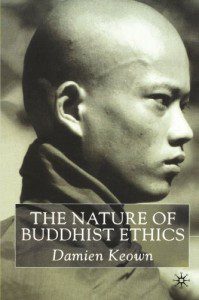
This is part 3 in a series on Buddhist ethics. Part 1 introduced our ‘orientation’ in studying Buddhist ethics today. It’s essential to know where you are in the first place if you want to go somewhere. In part 2, I focused on some of the early forays into the field in the 1970s and the hopeful atmosphere surrounding those early discussions.
1990s
While debates continued through the 1980s, it was not until the 1990s that another significant burst of activity took place. Part of this activity was two international conferences on Buddhist ethics sponsored by the Chung-Hwa Institute of Buddhist Studies in Taiwan (1990 and 1992). These conferences brought scholars, both laypeople and monastics, from around the world to discuss an extraordinarily wide variety of issues in Buddhist ethics.
However, despite these and the work of the late 1970s and 1980s, in 1992 Charles Hallisey rightly wrote that ‘We are still unable to produce convincing large-scale accounts that adequately frame and connect these more limited discussions and that also connect the study of Buddhist ethics to ethical reflections elsewhere’ (1992, p.284). This was in his review of ‘Recent Works on Buddhist Ethics’, which in covering works from 1979 to 1992 showed that while a wide range of topics had begun to be discussed, the overall number and quality was still low.
The same year, however, Damien Keown published The Nature of Buddhist Ethics, where he likewise noted that, ‘the total number of books on Buddhist ethics … can be counted on the fingers of one hand’ (Keown 1992, cited in Keown 2001, p.ix.). Keown’s book represented the first systematic coverage of Buddhist ethics and book-length comparison with a Western ethical theory, that of Aristotle. Charles Prebish suggests that at least part of the rapid growth of studies in Buddhist ethics that followed Keown’s book was because it ‘offered researchers a creative paradigm shift, useful for understanding the whole of the Buddhist ethical tradition’ (Prebish, 1993, pp. 107-108).
In 1994 Keown and Prebish co-founded of the Journal of Buddhist Ethics, an entirely online and free resource for the discussion of Buddhist ethics (1994). From that point on the number of articles with sophisticated analyses of Buddhist ethics rapidly grew. If we mark 1992 as a starting point, we can say that the past 20 years have provided an unprecedented rate and quality of work in Buddhist ethics. In 1996, the Journal of Religious Ethics featured yet another focus on Buddhist ethics including papers by Damien Keown and Charles Hallisey, as well as an introduction by Charles Prebish.
And yet, while philosophical sophistication has developed and the work of historians and anthropologists have brought increased data to work with, many of the debates of the 1970s have simply taken on new forms. In the next few posts, I shall sketch the contours of two of these debates: first whether Buddhist ethics represents a consistent moral theory to begin with, and second, if so, what that theory might look like.
But first, a bit of re-orientation by way of a Buddhist sutta…











